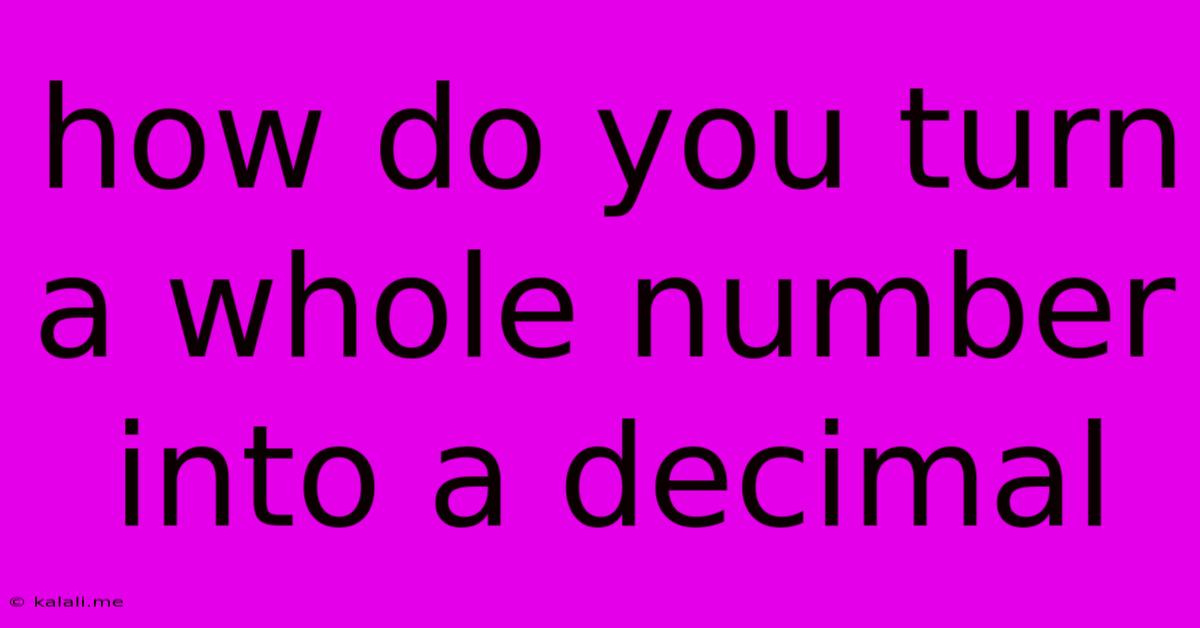How Do You Turn A Whole Number Into A Decimal
Kalali
May 10, 2025 · 2 min read

Table of Contents
How to Turn a Whole Number into a Decimal
This article will guide you through the simple process of converting a whole number into a decimal. While it might seem trivial at first glance, understanding this conversion is fundamental for various mathematical operations and applications. We'll explore the underlying concept and provide practical examples to solidify your understanding. This method is crucial for aligning numbers in calculations, performing decimal arithmetic, and representing quantities more precisely.
Understanding the Concept
A whole number, by definition, doesn't contain any fractional part. Decimals, however, represent numbers with both a whole number part and a fractional part, separated by a decimal point (.). The key to converting a whole number to a decimal is understanding that adding zeros after the decimal point doesn't change the value of the number.
The Simple Method: Adding a Decimal Point and Zeros
The easiest way to turn a whole number into a decimal is to simply add a decimal point followed by as many zeros as you need. For example:
- 5 becomes 5.0, 5.00, 5.000, and so on. The value remains 5.
- 27 becomes 27.0, 27.00, 27.000, etc. The value remains 27.
- 1000 becomes 1000.0, 1000.00, 1000.000, etc. The value remains 1000.
Why is this important?
This seemingly simple conversion has practical implications in several areas:
-
Aligning Numbers for Addition and Subtraction: When adding or subtracting decimals, it is crucial to align the decimal points. Converting whole numbers to decimals with trailing zeros allows for easy alignment and accurate calculations. For example: adding 5 and 3.75 becomes much easier when 5 is represented as 5.00.
-
Representing Quantities More Precisely: In many applications, including scientific measurements and financial calculations, representing a whole number as a decimal can improve precision. Adding zeros after the decimal point suggests a level of measurement accuracy. For instance, 5.00 meters implies a more precise measurement than just 5 meters.
-
Compatibility with Decimal Operations: Many computer programs and calculators require decimal inputs. Converting a whole number to a decimal ensures compatibility and allows for seamless calculations.
Examples
Let's work through a few more examples to illustrate the process:
- Convert 12 to a decimal: 12.0 or 12.000 (both are correct)
- Convert 3456 to a decimal: 3456.00 or 3456.0 (both are equally valid)
- Convert 1 to a decimal: 1.0, 1.00, 1.000, etc.
Conclusion
Converting a whole number into a decimal is a straightforward process. By simply adding a decimal point and trailing zeros, you maintain the numerical value while enabling a wider range of mathematical operations and providing increased precision. This seemingly simple conversion plays a significant role in various mathematical contexts and is essential for accuracy in calculations. Understanding this concept is key to working effectively with decimals in numerous fields.
Latest Posts
Latest Posts
-
How Many Cups Are In A Pound Of Lard
Jun 30, 2025
-
Why Did Jerry Thompson And Kelly Nelon Divorce
Jun 30, 2025
-
Allen And Roth Patio Furniture Replacement Parts
Jun 30, 2025
-
How Many Minutes Are In 20 Miles
Jun 30, 2025
-
How Many Days Is 72 Hours From Tuesday
Jun 30, 2025
Related Post
Thank you for visiting our website which covers about How Do You Turn A Whole Number Into A Decimal . We hope the information provided has been useful to you. Feel free to contact us if you have any questions or need further assistance. See you next time and don't miss to bookmark.